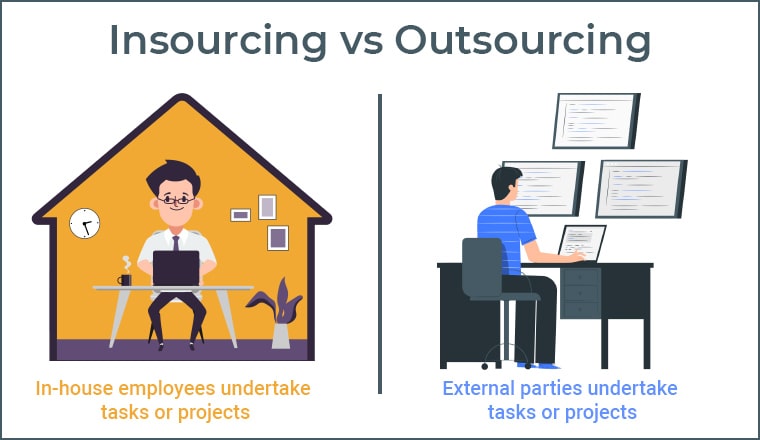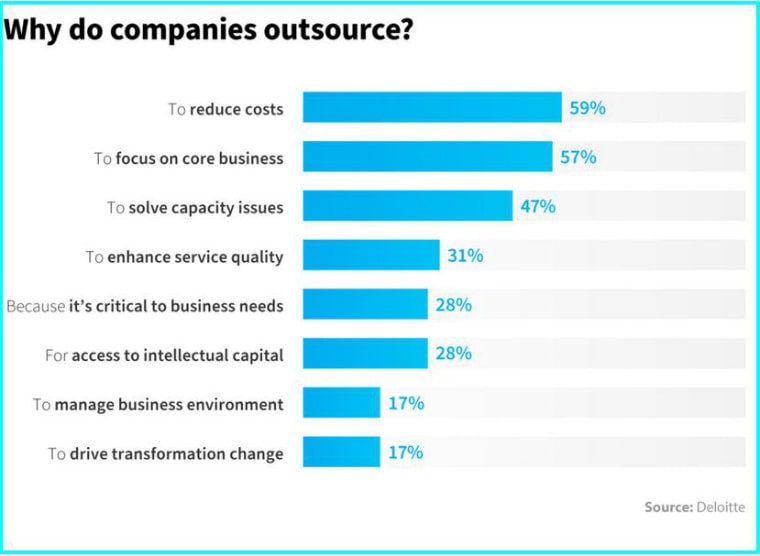
With short project cycles, effective management, and guaranteed ROI, can you get it all! In all, making a choice about choosing an insourcing or outsourcing company to opt for is a hard nut to crack. Fret not! Read the following post on outsourcing vs insourcing and you don’t have to worry though!
You must be familiar with outsourcing IT services, especially after the COVID hit. Now let’s comprehend what outsourced development is. And why it’s best to choose outsourcing software developers over internal IT departments for the best outcome. But before that let us brush up with little basics, for example why one must incorporate emerging tech in certain business processes.
1. Understanding Insourcing and Outsourcing Services
Before understanding the insourcing and outsourcing services, let us have a look at the stats by Google Trends, which shows the interest over time in outsourcing is higher between these two services. We can clearly see in this trend that between March 2022 to November 2023, number of adopting outsourcing services are more to insourcing.
1.1 Insourcing

Insourcing is more like a business agreement where one project that even could be outsourced by a third party is instead carried out by an implanted internal team. In simple words, it’s a technique of hiring staff on behalf of the company and rendering tasks or functions to work internally instead of providing the work to the outsourced team. So here what can be done is?
- Build competitive advantage over peers, especially ones using outsourcing providers for their tech-based operations.
- Retain any Intellectual Property during the employees’ tenure
- Keep one culture – this can be advantageous, as a company culture can clash with outsourced suppliers
- Cost saving – if you know what good looks like for the service you want to insource, then you can recruit the right people and save considerable service costs
- Take direction and control of the operational processes in-house.
1.2 Benefits of Insourcing
1. Agility and Flexibility – Business expansion and reduction cycles are increasing at a rapid pace. This leads to increased agility. Unlike outsourcing, insourcing won’t slow down necessary time-sensitive procedures.
2. Solutions catered to specific needs – Imagine you have already outsourced services. Now chances are pretty of you receiving more or less the same service as competitors — particularly if your supplier works with multiple businesses within the sector.
3. Enhanced communication – By being able to call on teams with specific skill sets and organizational knowledge, insourcing enables you to address some of the cons of outsourcing, such as issues with communication (e.g. language barriers) and quality control (e.g. accountability). Overcoming these obstacles speeds up the delivery of a project, too.
Take a look at this quora post. Here Andrew Kurilo is mentioning some of the major benefits of insourcing.

1.3 Tips for Establishing a Successful Insourcing Service
- Share the vision and business model
- Articulate service expectations in prior
- Business case clarity
- Try implementing an appropriate performance management structure
- Do you have an entry and exit map prepared
- Have you any knowledge about governance
- Develop a service and contract re-shaping process and ongoing performance benchmarking to assess value for money against pre-defined baselines
So that was all about the insourcing process/local jobs, now it’s time to focus on outsourcing! How does it feel to opt for services outside the organization?
1.4 What is Outsourcing?
Choosing outsourcing vendors is a business practice in which a company hires a third party to perform tasks, handle operations or provide services for the company.
For more understanding, check out this outsourcing introductory YouTube video.
In simple words, they are third-party providers who tend to use their own workers or computer systems to perform the tasks or services either on-site at the hiring company’s own facilities or at external locations. Some of the best examples we can think of as of now are IBM and FedEx Supply Chain. These tech giants mostly tend to rely on third-party services reason could be anything a cost-saving tactic or enhanced logistics.
Some breakthrough reasons why people outsource:
- Reduce or control costs
- Gain access to IT resources and technical support
- Improve business and customer focus
- Accelerate project to a great extent
- Gain access to management expertise unavailable internally
- Reduce time to market
1.5 Benefits of Choosing an Outsourcing Company

1. Focus on Core Competencies – More and more businesses are unable to focus on their key aspects due to their unsolved technical needs. Your back-office operations are piling on. This expansion can tie up your human and financial resources at the expense of the core activities that made your company successful in the first place. By outsourcing, you cannot just focus on your business goals but even non-core functions that you were unable to take into account before. You free up personnel to focus on the contract itself.
2. Cost-effective – There are times when you may find the expense of purchasing equipment or needing a new location can be prohibitive. In such cases, outsourcing plays a crucial role among the available viable options. It will save the company’s expenses and at the same time complete the project quickly. It might cost far less than the price of expanding, and it is both more efficient and less expensive than relocating an entire office space with new services and new processes. Not choosing third-party vendors at the initial stages would result in increased costs in regard to
- Hiring search
- Onboarding
- Healthcare and other benefits
- Payroll Taxes
- Increased need for workers in management and HR positions.
3. Cultural differences are no longer a problem – Earlier there was a time when outsourcing important projects to different companies was a big No-No! Language and cultural barriers were the major issues. Fortunately, the situation is no longer the same anymore. No matter how different the language is or the costs and time zones are, outsourcing is no longer bound to these factors. In fact, these services are now considered outsourcing pros.
4. Flexibility – Above all, outsourcing gives you the ability to quickly add and remove capacity to fit variable requirements. Here your insourcing provider will require to have the capacity available to meet the peak periods of the year. This results in waste and unutilized capacity. Whereas by outsourcing you will receive this additional capacity and remove it when it is no longer required. Flexibility can also be considered when you require better control. Outsourcing vendors often are asked to ‘spin up’ virtual machines as testing environments whenever required.
5. Get a Competitive Advantage – By outsourcing companies, the ultimate benefit you receive is getting a competitive edge. Their expert-level knowledge may seem time-consuming at first, but it will surely provide fruitful results later on. When you outsource from other countries you aren’t just providing your customers with best-of-breed services, but increasing your productivity while managing your in-house resources intelligently.
Overall, Successful outsourcing requires a strong understanding of the organization’s capabilities and future direction. Outsourcing can be undertaken to varying degrees, ranging from total to selective and several other models of outsourcing.
2. Incorporating Tech in Your Existing Business Processes
The dynamics of the market are changing at a severe pace therefore, you have to keep at it! Its time to retain your edge over your competition is to leveraging the latest new technologies. Whether it’s about collaborating with remote colleagues using video-conferencing software or texting customers to request a Google review, technology allows business organizations to reach their goals.
Imagine yourself driving an old car where everyone else around you has started driving automatic once. What we are saying is your competitors and other companies in the market have already started employing a lot of devices, apps, and point-of-sale (POS) systems in your daily operations. These devices gather large amounts of data, including customer information, payroll records, sales histories, and many more. If these devices are integrated and are able to “talk” to one another, then you can maximize the data shared across systems. Many companies utilize this gathered information in decision-making to save money and gain more control over their business processes.
So where are you? Why haven’t you considered well-integrated technologies yet? Down below we would like to mention certain benefits of combining technology with your business objectives.
1. Better Customer Services – As a business, it is very crucial to cater to a particular base of clients and customers. And in order to make them continue to use your services and products, you have to meet customer demands. With the help of existing data, data analytics applications can help you understand customer behavior and demands and to develop your ability to meet future demands.
2. Seamlessly collaborate with your executive team – A business function is said to succeed only when your team collaborates seamlessly. Companies no longer need to save multiple versions of documents and spreadsheets and email them to each other in order to get feedback from their colleagues. For example, Google docs enable multiple team members to work on and review documents simultaneously, saving time. In addition, Project management solutions such as Basecamp and Teamwork let companies effectively organize their projects, assign tasks, track progress and maintain schedules.
3. Enhance productivity – Earlier, it used to take a while for data to be retrieved and shared. With integrated technologies, your data is more organized, accessible, and easier to share. Your employees don’t waste time waiting for the data they need, and there is less room for error when everyone is sharing the same database. This lets your employees focus on improving the business, leading to better productivity.
Overall, technology can assist you in numerous ways and can benefit your business in several ways. So if you haven’t now; it’s time to get on board or you may have a lot to lose. Moving on, let us find out how selecting an IT outsourcing partner can be beneficial.
3. Time to Streamline Your Business Process With a Reliable Service Provider
It’s pretty hard to say which one is the best viable option for your business. Whether to insource or outsource highly depends on your needs and requirements. For instance, if you are developing a mobile application or ensuring good customer support then an outsourcing partnership is right for you. But in case, if your company is involved in the development of an unconventional product or non-core functions, does some scientific research, or needs to have a standalone department that provides support to your core business throughout its life cycle, then insourcing is what you need.
So this is it, You know what is insourcing and outsourcing, insourcing vs outsourcing and how is it beneficial for your space. Time to make the right choice. The bad news here is that it can be pretty daunting to compare vendors on an apples-to-apples basis.






This article clearly explains the difference between outsourcing and insourcing. Whether to insource or outsource highly depends on your business needs and requirements. It’s also possible to use a hybrid model, using both insourcing and outsourcing at the same time.